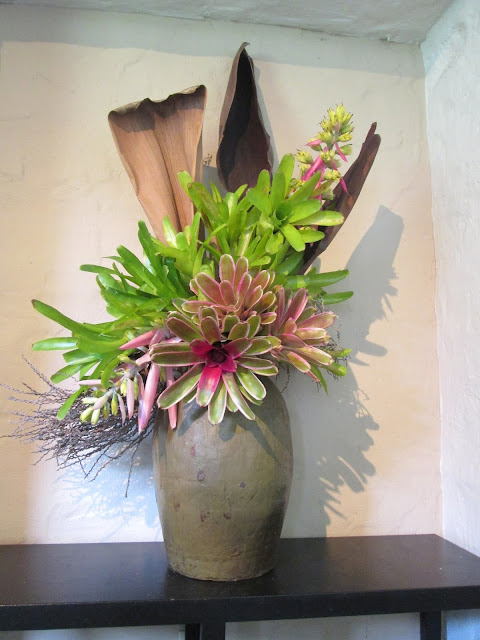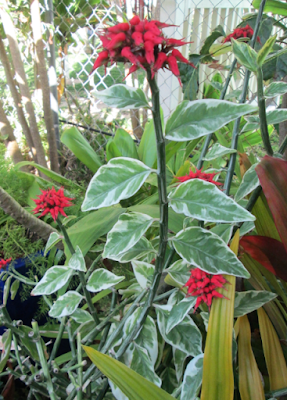For several years now I have been growing Asian Yard Long Beans in the summer time. Possibly they will grow OK in Hawaii's winter but I have always associated them with summer along with tomatoes (June 1917) and egg plants. Fruiting vegetables need more hours of sunlight than the leafy veges. That being said, my Yard Long Beans get light shade in the afternoon from my Curry Leaf Tree (Aug. 2015 ) and still produces well.
I grow my Yard Long Beans in a 10 gallon pot as I just have to supply enough for me. I rig up a tall natural trellis of a few dead tree branches for the beans to grow up. My first plants were grown from beans from a mature bean pod found in a bunch of Yard Long Beans that I had bought. Actually, I inspected all the bunches at the store to find one with an old bean pod tucked in the middle by the farmer. I dried the bean pod on the window sill for a few days and then planted several of the beans. Now each summer I allow one bean pod to grow old on the plant so I can harvest the seeds and store them in the fridge for next summer.

I usually plant several seeds in the 10 gallon container but only the strongest 4 or 5 get to grow big. I give them a hand full of 10-30-10 fertilizer once they get going and then a sprinkle of the same fertilizer every weekend once the flowering starts. I am sure this horrifies organic growers but the biggest output of the plants, especially in container plants, really is a result of fertilizer use and that 30% Phosphorus really pushes flowering and fruiting.

The Yard Long Bean has a pretty mauve colored flower that turns to a cream color by mid day. By the next morning there will be two cute tiny beans growing.....about one inch long From then on the length of the bean seems to double every night. Something fun to observe with the grand children each morning. Although the beans can get super long if you leave them to grow old on the vine, despite their name, you really need to pick them when they are about half a yard long and still fairly narrow and crisp. If you are into eating them raw, then even more so. Something different to put on the raw veges and dip tray at the next party. Mostly I use the beans in stir-fries. My first meal of the bean season is always a stir fry of canned mackerel in tomato sauce with curry powder, onions and the chopped beans. A favorite from my days living in Samoa. I have to have it with boiled bread fruit, (Sept. 2011) which is also in season in the summer.
The Yard Long Beans can last several days in a plastic bag in the fridge. I freeze extra beans for later use. I pick beans in the morning and put them in the fridge until I have enough to chop and freeze after a few days. The flowers, and therefore the beans, grow right next to the vine tips so you have to be careful when pulling off the beans as you do not want to harm the actual growing tip with its reproducing cells which will go on to produce more flowers and beans if not damaged.
 |
| Yard Long Beans being prepped at a produce market in Bangkok, Thailand. |
Aloha
PS Junly 2020
Last month my Yard Long Beans were not developing properly. The first flush of beans had been fine but the second flush of beans were stunted with shorter beans and the ends were narrow. I asked around on Facebook garden group if anybody knew what the problem was. Nutrition? Disease? I got no answers there and nor could I find answers on the internet. Anyways.....I gave the plants a big dose of Miracle Grow fertilizer figuring the plant might need extra micro nutrients and it seems to have solved the problem because the third flush of beans are back to normal. I am growing the beans in a container so I guess the soil was getting a bit exhausted.
Dec. 2024
Last year I spent a month traveling around the state of Kerala in South India. Whenever I had fried rice at a restaurant, I noticed that there was finely sliced Yard Long Beans in my meal. Here in Hawaii, we usually add green peas to fried rice and I do not think I have ever seen the long beans used. To me it made so much more sense.....afterall, why use peas that are usually have to be bought frozen when you have a local green vegetable in your garden that you can use in your fried rice. They cut it very tiny so it has a nice appearance of green sprinkled throughout the rice. Indians are often vegetarians, so I expect the beans add protein to the dish too.


















































